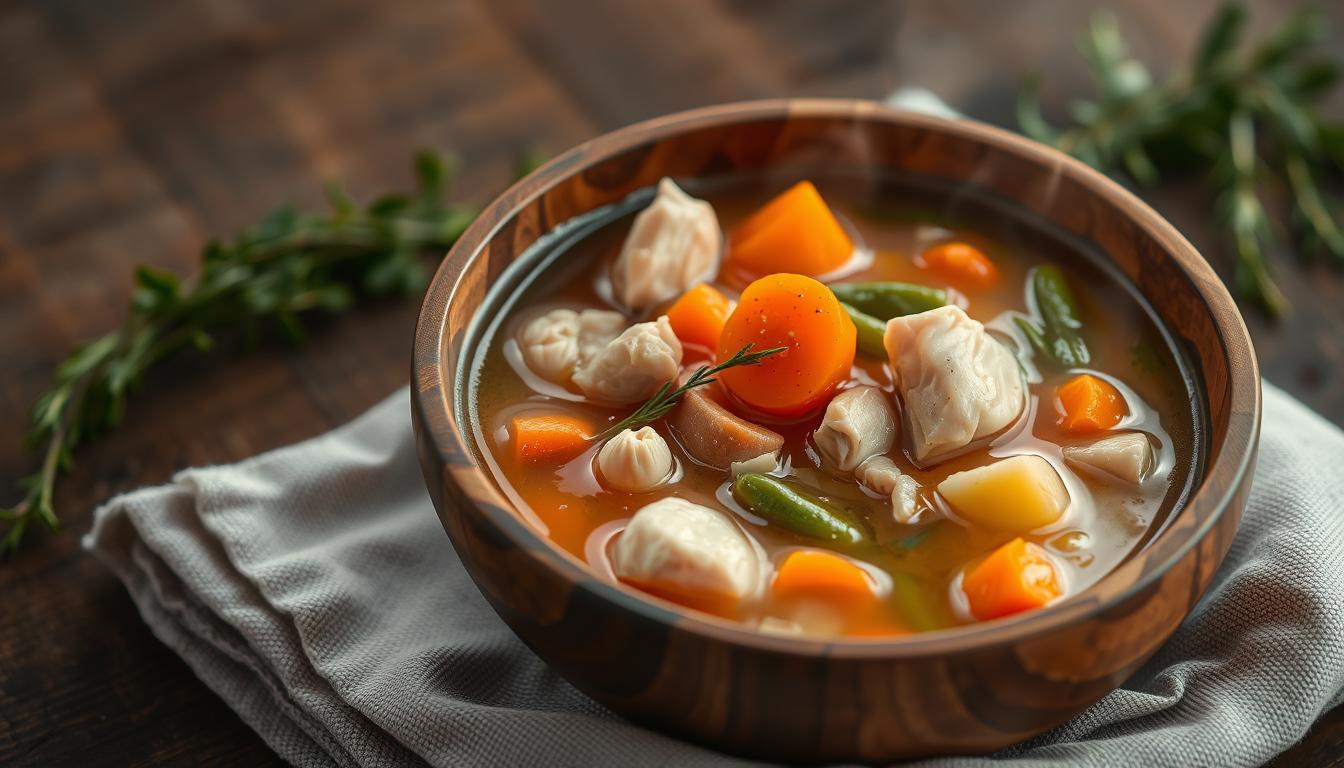Could a simple bowl of chicken soup help manage endometriosis symptoms? This condition affects 176 million women worldwide. Our endo friendly low FODMAP chicken soup is a gut-friendly, anti-inflammatory option. It’s packed with nutrients and follows an endometriosis-specific diet.
This diet can help ease symptoms and improve overall health. It’s a powerful way to use food for healing.
Endometriosis: A Painful Chronic Condition
Endometriosis is a chronic and painful condition that affects millions globally. It happens when tissue that lines the uterus grows outside of it. This tissue grows on other organs in the pelvis, like the ovaries and fallopian tubes.
As this tissue acts like the uterine lining, it thickens and bleeds with each cycle. This causes inflammation, scarring, and adhesions. These symptoms can be very painful and affect daily life.
The symptoms of endometriosis include heavy and painful periods, chronic pelvic pain, and fatigue. According to the Cleveland Clinic, it affects 1 in 10 women in the U.S. and up to 200 million worldwide.
Causes and Diagnosis of Endometriosis
The exact causes of endometriosis are not known. But, genetics, hormones, and environment play a role. Research shows that diet can make symptoms worse. Foods like gluten, dairy, and red meat can increase inflammation.
Diagnosing endometriosis involves medical history, physical exams, and imaging tests. Sometimes, a laparoscopy is needed. Understanding endometriosis and its symptoms is key to managing it.
By changing diet and lifestyle, people with endometriosis can find relief. This can improve their quality of life significantly.
The Role of Diet in Managing Endometriosis Symptoms
Diet is key in managing endometriosis symptoms. This condition causes inflammation when tissue like the uterine lining grows outside the uterus. Eating an endometriosis diet rich in anti-inflammatory foods and estrogen-balancing nutrients can help. It can reduce pain, nausea, fatigue, and other symptoms.
Fighting Inflammation with Anti-Inflammatory Foods
Endometriosis is an inflammatory disorder. Eating anti-inflammatory foods can help ease the pain. Some top choices are:
- Omega-3 rich fish like salmon, mackerel, and sardines
- Leafy greens, broccoli, and other cruciferous vegetables
- Turmeric, ginger, and other anti-inflammatory spices
- Nuts and seeds high in healthy fats
These endometriosis diet foods help reduce inflammation. They also provide important nutrients for health.
Balancing Estrogen Levels with Phytoestrogens
Excess estrogen can stimulate endometriosis growth. So, eating estrogen-balancing foods is important. Phytoestrogens, found in plants, can help balance estrogen levels. Good sources include:
- Flaxseeds and chia seeds
- Soy products (in moderation)
- Legumes like chickpeas and lentils
- Berries, pomegranates, and citrus fruits
By eating these nutrient-rich, anti-inflammatory and estrogen-balancing foods, we can manage endometriosis symptoms through diet.
The Low FODMAP Diet and Gut Health
The low FODMAP diet can change lives for those with endometriosis. It was first made for people with irritable bowel syndrome (IBS). Now, it helps with the stomach problems that come with endometriosis too.
FODMAPs are carbs that the small intestine can’t absorb well. This causes stomach pain and other issues. By cutting out foods that make symptoms worse, the diet can lessen bloating and pain. It also helps with inflammation and hormone balance, making endometriosis symptoms better.
Identifying and Eliminating High FODMAP Foods
Some foods to avoid with endometriosis include:
- Garlic and onions
- Apples, bananas, pears, and avocados
- Wheat-containing products, such as bread, pasta, and biscuits
- High FODMAP sweeteners like fructose, honey, and high fructose corn syrup
- Dairy products, including cow’s milk, goat’s milk, and cheese
- Certain alcoholic beverages, such as beer, rum, and wine
But, you can eat:
- Vegetables like zucchini, carrots, bell peppers, and cucumbers
- Fruits such as blueberries, lemons, strawberries, and pineapples
- Gluten-free bread, rice bread, and corn tortillas
- Dark chocolate and pecans
Following a low FODMAP diet is a big step towards better symptoms and gut health for those with endometriosis.
Endo friendly low FODMAP chicken soup
If you have endometriosis, our low FODMAP chicken soup is a great choice. It’s made with bone broth, which is full of nutrients. This soup helps soothe your stomach and fights inflammation.
Broccoli, cauliflower, and gentle spices are in this soup. They help fight inflammation and support your health. This soup is a tasty, gut-friendly option for those with endometriosis.
To make this endometriosis friendly soup, we start by cooking onions, garlic, and ginger in avocado oil. Then, we add diced chicken, broccoli, cauliflower, and herbs like turmeric and thyme. We simmer it all in bone broth until it’s flavorful and the veggies are soft.
This low FODMAP chicken soup is comforting and full of nutrients. It’s great for lunch or dinner. It can really help improve your health.
The Benefits of Bone Broth
Bone broth is a superstar for managing endometriosis. It’s simmered for hours or days. This process extracts minerals, collagen, and compounds that heal the gut, reduce inflammation, and support detoxification.
The gelatin in bone broth seals the gut lining. This improves nutrient absorption and prevents leaky gut, a common issue for those with endometriosis.
Soups made with bone broth or meat stocks are easy to digest. They provide essential vitamins, minerals, and amino acids. These nutrients nourish the body and ease endometriosis symptoms.
The benefits of bone broth extend beyond soothing the gut. It’s a key part of a healing diet for those with endometriosis.
Gut-Healing Broths
Bone broths and meat stocks are packed with gut-healing compounds:
- Collagen and gelatin, which help seal the gut lining and improve nutrient absorption
- Glucosamine and chondroitin, which reduce inflammation and support joint health
- Amino acids like glycine and proline, which assist in detoxification and liver function
- Essential minerals like calcium, magnesium, and phosphorus, which support overall health
Adding bone broth endometriosis to your diet can change the game. Whether in soups, stews, or sipped alone, it’s a game-changer for managing symptoms.
Healing Power of Broccoli and Cauliflower
Broccoli and cauliflower are superfoods for managing endometriosis symptoms. They are packed with indole-3-carbinol and sulforaphane. These compounds help break down and get rid of extra estrogen, a big problem for endometriosis.
By helping your body get rid of estrogen, cruciferous vegetables can balance your hormones. This can ease the pain, heavy bleeding, and other symptoms of endometriosis. Adding broccoli, cauliflower, and other brassicas to your meals is a natural way to help your body fight this chronic condition.
Harnessing the Benefits of Cruciferous Veggies
Broccoli and cauliflower have special phytochemicals that fight inflammation and protect against damage. These nutrients can lessen the inflammation and stress that come with endometriosis. Also, their fiber helps get rid of extra estrogen, which can make symptoms better.
- Broccoli has indole-3-carbinol, which helps break down estrogen and get rid of it.
- Cauliflower is full of sulforaphane, a strong antioxidant that fights inflammation and helps with detox.
- Both broccoli and cauliflower are high in fiber, which is key for keeping hormone levels balanced.
Adding these broccoli endometriosis and cauliflower endometriosis superfoods to your meals can unlock their healing power. This is a big step towards controlling your endometriosis symptoms.
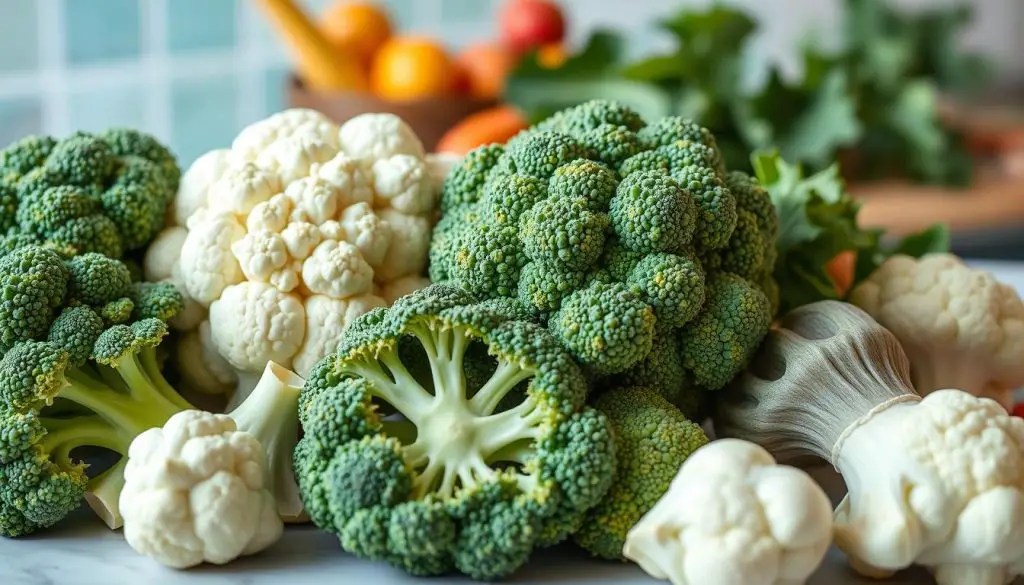
| Vegetable | Key Compound | Benefit for Endometriosis |
|---|---|---|
| Broccoli | Indole-3-carbinol | Promotes estrogen metabolism and elimination |
| Cauliflower | Sulforaphane | Reduces inflammation and supports detoxification |
Omega-3 Fats: Nature’s Anti-Inflammatory
Omega-3 fatty acids are powerful allies in fighting endometriosis. They have strong anti-inflammatory effects that can ease the pain of this chronic condition.
These fats work deep within cells to lessen inflammation. This helps calm the body and reduces cramps, pelvic pain, and other discomforts. Eating foods rich in omega-3s can greatly improve life for those with endometriosis.
Nourishing Sources of Omega-3s
The top sources of omega-3 fatty acids include:
- Fatty fish like salmon, sardines, and mackerel
- Nuts and seeds, such as walnuts, flaxseeds, and chia seeds
- Plant-based oils, including flaxseed, walnut, and canola oil
Eating these omega-3-rich foods a few times a week can offer big benefits. They help fight inflammation and aid in your body’s healing.
| Omega-3 Rich Food | Serving Size | Omega-3 Content (mg) |
|---|---|---|
| Wild Salmon | 3 oz | 1,800 |
| Walnuts | 1 oz | 2,500 |
| Flaxseeds | 1 tbsp | 1,600 |
| Chia Seeds | 1 tbsp | 2,500 |
| Canola Oil | 1 tbsp | 1,200 |
Adding these omega-3 rich foods to your diet can help manage endometriosis symptoms. They support your health with their anti-inflammatory fats.
Fiber: A Key to Balancing Estrogen Levels
Fiber is key in managing endometriosis by balancing estrogen levels. Too much estrogen can make endometriosis symptoms worse. Fiber helps get rid of estrogen through bowel movements. Foods like fruits, veggies, whole grains, and legumes are great for this.
These foods help keep estrogen levels healthy. They stop harmful estrogen buildup that can make endometriosis worse.
For those with endometriosis, eating enough high fiber foods is important. It helps regulate hormones and reduce inflammation. Adults should aim for 35 grams of fiber daily to help with these issues.
Fiber-Rich Foods for Endometriosis
- Fruits: Berries, apples, pears, oranges
- Vegetables: Broccoli, spinach, artichokes, Brussels sprouts
- Whole grains: Oats, quinoa, brown rice, whole wheat bread
- Legumes: Lentils, black beans, chickpeas
- Nuts and seeds: Almonds, chia seeds, flaxseeds
Eating these high fiber foods helps your body balance estrogen. It also manages endometriosis symptoms.
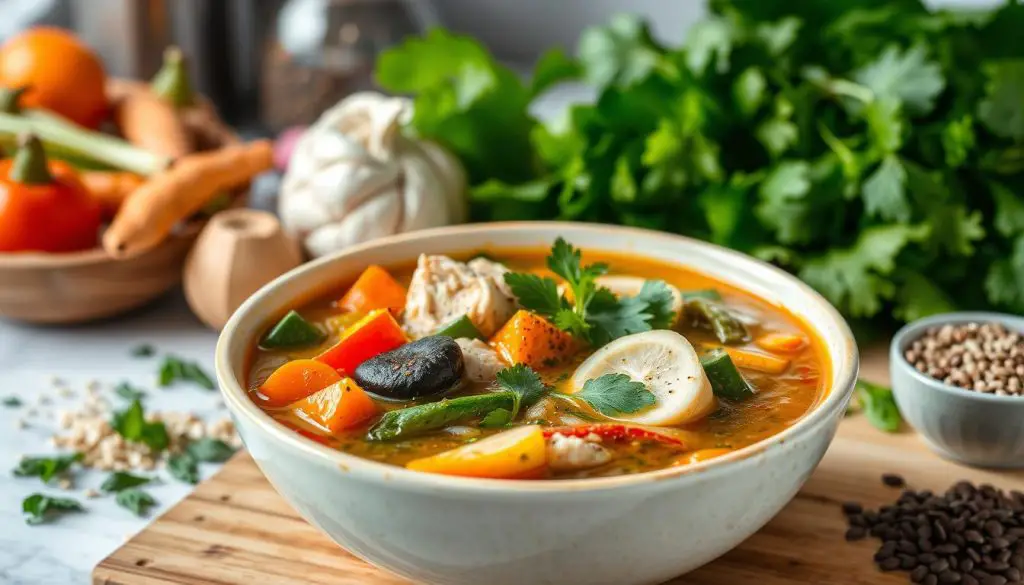
Avoiding Inflammatory Foods
For those with endometriosis, a diet rich in nutrients is key. But, it’s also vital to avoid foods that can make symptoms worse. Foods like processed items, fried foods, sugary drinks, and alcohol can increase inflammation.
These foods often lack good nutrients but are full of unhealthy fats, refined carbs, and additives. Eating a diet rich in whole, plant-based foods can help. This can lead to less pain, bloating, and other symptoms for those with endometriosis.
Foods to Avoid with Endometriosis
- Processed foods – such as packaged snacks, fast food, and deli meats, which are often high in unhealthy fats, refined carbs, and additives
- Fried foods – including fried chicken, french fries, and doughnuts, which can increase inflammation
- Sugary drinks – such as soda, fruit juices, and sweetened coffee drinks, which spike blood sugar and promote inflammation
- Alcohol – which can disrupt hormone balance and worsen inflammation
By cutting down on these foods and adding more anti-inflammatory options, we can fight inflammation. This might help ease endometriosis symptoms. The goal is to find a diet that fits your body’s needs.
The Role of Antioxidants in Endometriosis
Endometriosis is a chronic condition that causes a lot of pain and discomfort. It leads to inflammation and oxidative stress in the body. Luckily, antioxidants can help manage its symptoms. They fight free radicals and reduce inflammation, slowing down the disease’s progression.
Antioxidants are key in fighting oxidative stress linked to endometriosis. Research shows that endometriosis is tied to high levels of free radicals and low antioxidant levels. This imbalance can make symptoms worse and help the disease spread.
Eating foods rich in antioxidants is essential for those with endometriosis. Berries, leafy greens, nuts, and seeds are great sources. These foods boost the body’s defenses. Eating more of these foods can help improve health and reduce symptoms.
| Antioxidant-Rich Foods | Key Antioxidants |
|---|---|
| Berries (blueberries, raspberries, strawberries) | Vitamin C, Anthocyanins |
| Leafy Greens (spinach, kale, Swiss chard) | Vitamin C, Carotenoids, Flavonoids |
| Nuts and Seeds (walnuts, almonds, chia seeds, flaxseeds) | Vitamin E, Selenium, Omega-3 Fatty Acids |
| Turmeric | Curcumin |
| Green Tea | Catechins |
Adding a variety of antioxidant-rich foods to your diet is a big step in managing endometriosis. These foods are natural and help fight oxidative stress. They can also reduce the severity of symptoms.
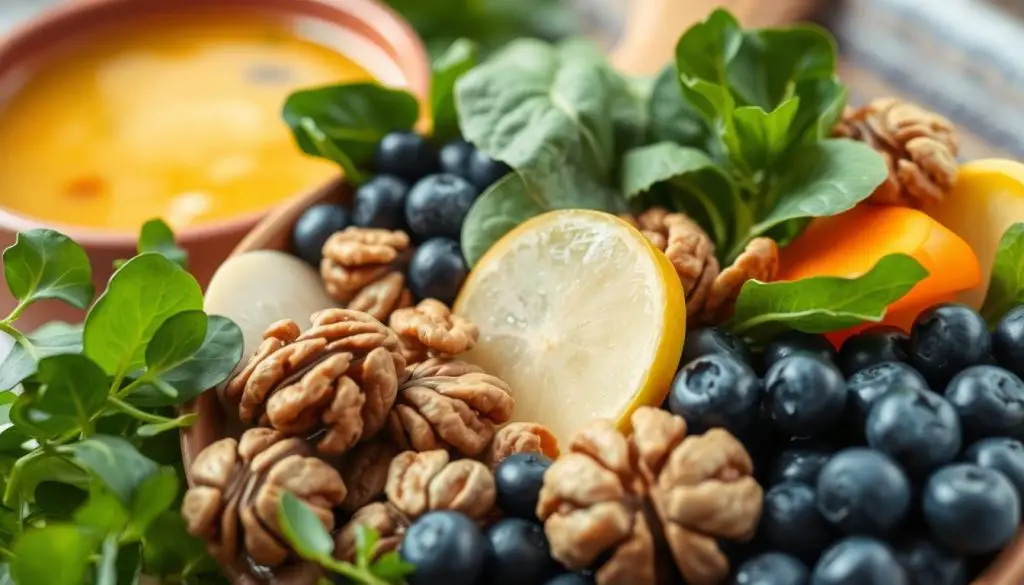
Organic vs. Conventional: Reducing Pesticide Exposure
For those with endometriosis, choosing organic foods can make a big difference. It helps reduce exposure to pesticides and toxins. These chemicals can cause hormone imbalances and lower antioxidant levels, making endometriosis symptoms worse.
Pesticides like organochlorines and organophosphates harm hormonal pathways and reduce antioxidant defenses. By choosing organic fruits and veggies, people with endometriosis can avoid these harmful substances. This supports their health and well-being.
Targeting the Dirty Dozen
Buying organic versions of the “Dirty Dozen” produce items can help minimize pesticide exposure. This list includes strawberries, spinach, and kale. These fruits and veggies tend to have high pesticide residues when grown conventionally.
- Strawberries
- Spinach
- Kale
- Nectarines
- Apples
By making these simple swaps, we can boost our bodies’ natural defenses. This gives our endometriosis the best chance to be managed through diet.
Hidden Hormones in Food
People with endometriosis need to watch out for hidden hormones in food. Dairy and meat can have extra hormones that mess with our body’s balance. This can make endometriosis symptoms worse.
To stay away from these hormones, it’s smart to pick organic or hormone-free foods endometriosis. Choosing organic dairy endometriosis and hormone-free meats helps manage our condition. It also supports our hormonal health.
The Importance of Organic and Hormone-Free Options
Dairy and meat often have added hormones. These can upset our hormone balance and make endometriosis symptoms worse. These hidden hormone sources come from growth hormones for animals or natural hormones in them.
- Opt for organic dairy endometriosis products, as they are free from added hormones and other synthetic additives.
- Choose hormone-free foods endometriosis, such as grass-fed, pasture-raised meats, to minimize exposure to exogenous hormones.
- Avoid conventional dairy and meat products, as they may contain hidden hormone sources that can disrupt your natural hormone balance.
By making these simple diet choices, we can take an important step in managing our endometriosis and supporting our overall hormonal health. Remember, every small change can make a big difference in our journey towards better well-being.
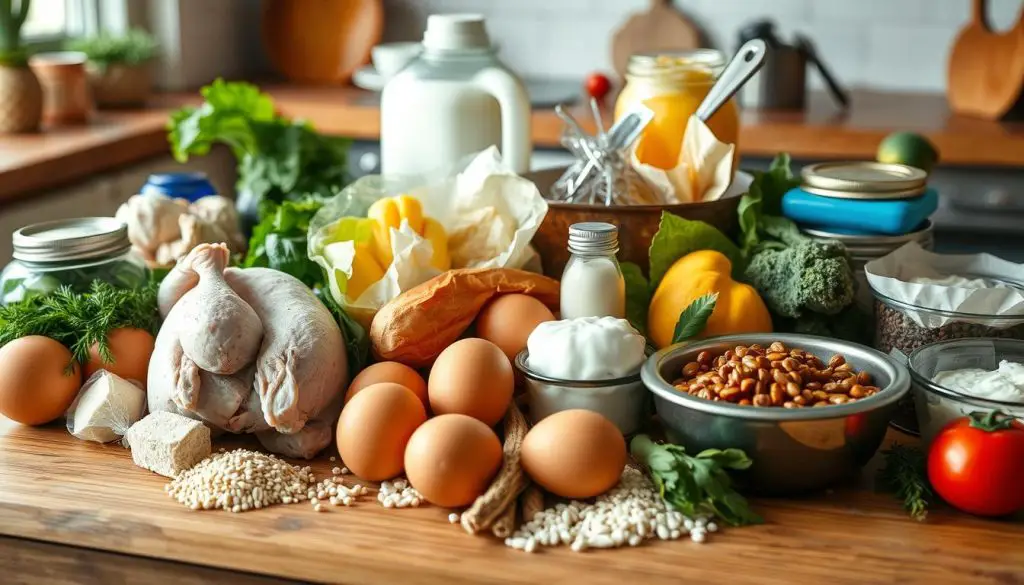
Meal Planning for Endometriosis
Effective endometriosis meal planning is key to managing this chronic pain through diet. By planning endo-friendly meal prep, people with endometriosis can eat the right foods. These foods help their body stay healthy and fight inflammation.
When planning meals, you might make bone broth soups, prep veggies, and keep nuts and fruit ready. This way, you control how much you eat and avoid foods that might hurt. With some planning, you can make your diet better and feel better too.
Here are some tips for your endometriosis meal planning:
- Make a weekly menu of meals and snacks that are good for endometriosis
- Fill your pantry and fridge with what you need for your favorite recipes
- Make a big batch of bone broth, vegetable soups, and other healthy dishes
- Chop and portion fresh veggies for quick meals
- Make a shopping list so you don’t forget anything
By spending a bit of time on endo-friendly meal prep, you can make your diet better. This can help ease your endometriosis symptoms with a diet full of anti-inflammatory foods.
Endometriosis-Friendly Recipes
To help those with endometriosis, we’ve put together a list of endometriosis-friendly recipes. These recipes are full of ingredients that fight inflammation and balance hormones. Our recipes include soothing soups and main dishes with omega-3 rich salmon. They aim to reduce inflammation, improve gut health, and ease endometriosis symptoms.
Our dishes are filled with broccoli, cauliflower, and salmon. These foods help detoxify excess estrogen and lower inflammation. Adding these recipes to your diet can help manage your condition through food’s healing power.
Our Cream of Broccoli Soup is a comforting option for 4 people. It can be kept in the fridge for 2 days or frozen for 4 months. It’s made with broccoli, cauliflower, leek, ghee or duck fat, chicken stock, and egg yolks. This soup helps heal and repair the gut lining, providing great nutrition for those with endometriosis. Explore our collection to find meals that meet your needs.
Source Links
- https://www.ssmhealth.com/SSMHealth/media/Documents/slucare/services/obstetrics-gynecology-womens-health/endometriosis-diet-booklet.pdf
- https://quirkycooking.com.au/2021/03/endometriosis-awareness-month-gut-health-tips-healing-soups/
- https://alittlebityummy.com/blog/endometriosis-surgery-and-me/
- https://chiavaye.com/blogs/endometriosis/endometriosis-diet?srsltid=AfmBOoo09F8iRoaBVz1UDaBiuAl-t4UjOSfaKkTgKB1cEJeqYxwQLthI
- https://www.businessinsider.com/guides/health/conditions-symptoms/endometriosis-diet
- https://mro.massey.ac.nz/bitstreams/8c557976-27cf-4b12-8745-257d506e0070/download
- https://www.verywellhealth.com/endometriosis-diet-7105372
- https://www.ibsdiets.org/fodmap-diet/fodmap-food-list/
- https://www.pinterest.com/ideas/low-fodmap-gut-healing-recipes/928909127624/
- https://www.goodreads.com/book/show/49197482-the-30-minute-low-fodmap-cookbook
- https://www.theroastedroot.net/immunity-boosting-turmeric-chicken-soup/
- https://realbalanced.com/recipe/low-fodmap-anti-bloat-anti-inflammatory-healing-carrot-turmeric-ginger-soup/
- https://thyroidpharmacist.com/articles/best-diet-for-hashimotos-hypothyroidism/
- https://chriskresser.com/5-causes-of-ibs-your-doctor-may-not-be-looking-for/comment-page-6/
- https://www.pinterest.com/ideas/anti-inflamatory-low-carb-soup/950632526725/
- https://www.usenourish.com/blog/4-week-gut-protocol-meal-plan
- https://health.clevelandclinic.org/endometriosis-diet
- https://thyroidpharmacist.com/articles/food-sensitivities-and-hashimotos/
- https://chiavaye.com/blogs/endometriosis/endometriosis-diet?srsltid=AfmBOorP8vtFthn51Axh-7ql3mgs0VJoOP0TQLlHIoRbNgc3X2jViCFR
- https://greatist.com/eat/low-fodmap-recipes
- https://www.medicalnewstoday.com/articles/322897
- https://www.crampedstyle.me/dining-in-dining-out/tag/endo diet
- https://thedietologist.com.au/what-is-the-best-diet-for-adenomyosis/
- https://thebalancedblonde.com/2014/06/23/why-im-transitioning-away-from-veganism/
- https://www.fodmapeveryday.com/the-hidden-culprits-12-common-triggers-of-ibs-you-may-not-know-about/
- https://againstallgrain.com/2016/05/21/fighting-ulcerative-colitis-flare-up/
- https://chiavaye.com/blogs/endometriosis/endometriosis-diet?srsltid=AfmBOoq7GymbOySeXsTOwvKmGC5MKBK9znb1eTwl1_BlP3CtAzI5SFMe
- https://www.everydayhealth.com/diet-nutrition/endomorph-diet/
